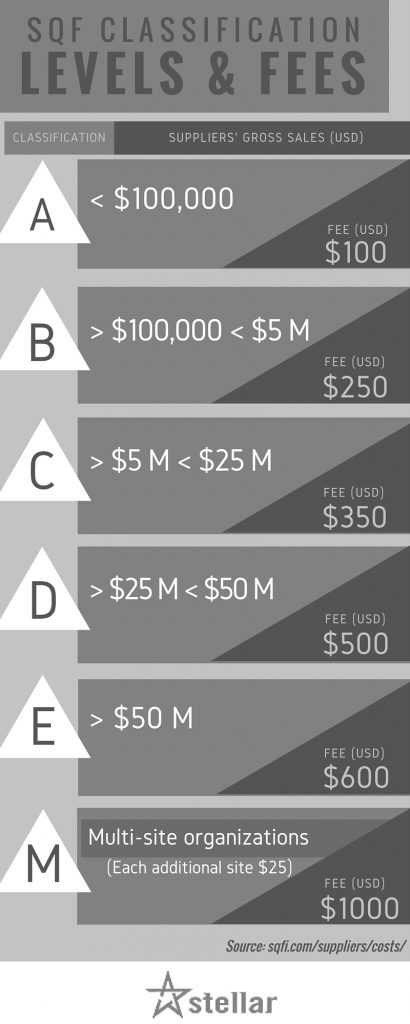Consumers’ increasing scrutiny of the food industry continues to crank up the hot seat for processors and manufacturers. Consumers not only want to ensure the food they’re putting into their bodies is safe, they want proof. This has led to a slew of third-party food safety certifications. The globally recognized Safe Quality Food (SQF) certification is one specific program gaining traction among food companies thanks to its comprehensiveness and consistency. Approved by the Global Food Safety Initiative (GFSI), the SQF program follows a “one world; one standard” vision, reducing the need for multiple food safety audits. So, what’s involved in a SQF certification? Let’s take a look at the basics of obtaining an SQF certification, from the fees to the steps involved.
What are the benefits of a SQF certification?
Why are some food companies opting for this food safety program over others? According to CERT ID, a global certification service provider, an SQF certification:
- Reduces or eliminates the need for multiple, redundant audits
- Protects brand integrity
- Assures customers and buyers that the certificate holder has achieved a high degree of competence in critical areas and is continually monitoring and improving product quality, safety and legality
What types of certifications are available?
The SQF standard has three levels of certification:
- Level 1 Food Safety Fundamentals—An entry level for new and developing businesses that covers only Good Agricultural Practices (GAP)/ Good Manufacturing Practices (GMP)/ Good Distribution Practices (GDP) requirements and basic food safety elements
- Level 2 Certified HACCP-based Food Safety Plans—Incorporates all Level-1 system requirements and additionally requires the completion of a food safety risk analysis of the product and its associated processes to identify the hazards and the action taken to eliminate, prevent or reduce their occurrence
- Level 3 Comprehensive Food Safety and Quality Management System—Incorporates all Level-1 and Level-2 system elements and indicates that a food quality risk analysis of the product and its associated process has been completed and that the actions taken to prevent the incidence of poor quality have been implemented
What are the costs involved?
The short answer: It depends. Your certification cost will vary depending on:
- Level and scope of certification
- Low-risk or high-risk product
- Use of external consultants
- Training requirements
- Your operation size (number and complexity of product lines)
However, if you’ve already undergone food safety auditing, you may only need to have your current policies and practices validated by an SQF consultant, updating them as-needed.
There is an annual fee required to register your company, based on your gross sales from the previous financial year. You must both register and pay your fees prior to setting up your audit.
The SQFI also touts these cost advantages, according to its website:
- Provides a platform for consistent improvement in process quality and safety, allowing processors valuable time and resources historically lost to multiple and conflicting audit standards
- Improves process management by helping to proactively identify and manage risk so as to avoid stock recoveries, market withdrawals and rework
- Increases yield by reducing material waste
- Streamlines risk and process management

How do you achieve an SQF certification?
According to the SQFI, the steps to achieve an SQF certification include:
- Learn the SQF Code—There are several ways to learn how to implement the SQF program within your food business:
- Attend an SQF Information Day; a day-long, in-person informational seminar designed to introduce food suppliers at all levels of the food chain to the benefits of food safety and quality certification
- Attend an on-site “Implementing SQF Systems” training course through a licensed SQF Training Center
- Take the online “Implementing SQF Systems” training course ($700)
- Train yourself by utilizing the SQF documents (free) on SQF’s website; and/or take the “Implementing SQF Systems” online examination
2. Select the relevant SQF modules—SQFI recognizes that food safety elements differ depending on your product or process. Because of this, the code is designed to meet individual requirements of each industry sector. View modules, broken down by category, here.
3. Register your company with SQF’s Assessment Database—You can read about first-time company registration here.
4. Designate an employee as the “SQF Practitioner”—This individual will serve as your company’s internal SQF expert. Further information on the requirements for an SQF Practitioner are available in sections 2.1.2.4 and 2.1.2.5 of the SQF Code, Ed. 7.2.
5. Choose your certification level—There are three levels to choose from, as outlined above.
6. Obtain proposals from SQF-licensed certification bodies—Contact a licensed Certification Body directly to obtain quotes and details on the SQF certification audit.
7. Conduct a pre-assessment (optional)—Either an SQF auditor or your SQF Practitioner can identify the “gaps” between your program and the desired level of SQF certification.
8. Choose a certification body and schedule an audit—Use the Licensed Certification Body Directory to find a certification body that can conduct an audit in your country.
9. Complete your initial certification audit (conducted by your certification body)—The audit includes a document review and facility assessment.
In next week’s post, we’ll review the specifics of the SQF initial certification audit, including the duration periods for each level.
If you’d like to learn more about the SQF certification, visit the SQFI website or email me at foodforthought@stellar.net.




This information is very helpful. Have you completed and published similar evaluations of the other GFSI certifications, FSSC 22000, BRC and IFS? If so, where can I access them. Thank you!
Best regards, Joe Shebuski